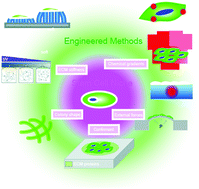Towards organogenesis and morphogenesis in vitro: harnessing engineered microenvironment and autonomous behaviors of pluripotent stem cells
Abstract
Recently, researchers have been attempting to control pluripotent stem cell fate or generate self-organized tissues from stem cells. Advances in bioengineering enable generation of organotypic structures, which capture the cellular components, spatial cell organization and even some functions of tissues or organs in development. However, only a few engineering tools have been utilized to regulate the formation and organization of spatially complex tissues derived from stem cells. Here, we provide a review of recent progress in the culture of organotypic structures in vitro, focusing on how microengineering approaches including geometric confinement, extracellular matrix (ECM) property modulation, spatially controlled biochemical factors, and external forces, can be utilized to generate organotypic structures. Moreover, we will discuss potential technologies that can be applied to further control both soluble and insoluble factors spatiotemporally in vitro. In summary, advanced engineered approaches have a great promise in generating miniaturized tissues and organs in a reproducible fashion, facilitating the cellular and molecular understanding of embryogenesis and morphogenesis processes.



 Please wait while we load your content...
Please wait while we load your content...
